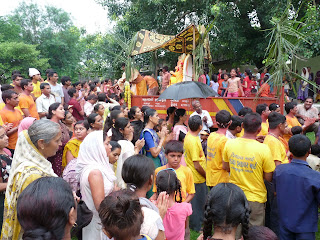
Of course we live in a fishbowl. We are always on display. Three foreign girls parading around in saris on our way to school are always a sight but, never more so it seems, than during this last festival; Navatry. Meg, Lyndi and I had so much fun dancing the night away with the garba circle in town. Each night we donned a different outfit; saris one night from our own collection, a borrowed one the next, traditional chanya chowdri after that - always decked out in our finest as the festival required. We always elicit looks, I mean, we do stand out but the looks turned into odd comments this week. "Why don't you have more ornaments on?" "Why doesn't your blouse match perfectly to your sari?" "Why are you garba steps so wide?" Most of the questions we have taken in stride. Gujarati's tend to be very forthcoming in their comments; to say the least. Honesty becomes brutal at times and they think nothing of it. But, this was a fun festival that everyone had been working up so much to us and we had really looked forward to participating in it. It's never easy to be the different one is a society of people that all dress identically aside from the difference in colors. It's not like a teacher will come in to school wearing the mandated sari and have it folded toga style. So, for us to throw our own spin on clothes, or to not have our hair done properly, or to simply opt for western dress to avoid comment - illicited many comments. By the end of the festival, we were all feeling our differences and really having a hard time handling the comments. It's hard to continue to embrace the culture when the culture is making it hard to do so by being critical of the steps you are taking.
While this was a frustrating aspect of the festival, there were more to make it extremely
 memorable. I loved the nights when Lyndi and I were able to go to Madhi and play garba with our students. Since we don't live in the village that we work, these times are really special to me, and to the kids as well. That first night especially, I can't remember how many houses we were invited into of students who's families I had yet to meet who put more food into our hands that I could handle to eat in one night's time. It was overwhelming to me at times, how happy and welcoming the parents were when we came into their homes and their children introduced us as their teacher; whom I'm sure they have heard plenty about over the last few months. In one home, Shrey's mother was sewing his outfit for the next night when he would be competing in a garba competition. She was hard at work gluing on more sequins than I would think possible, making the outfit colorful and shiny. I got to see him wearing this outfit the next night (and you can too - here is Shrey and I) along with his friends Dhuval and Ashok, who are all in my Spoken English class.
memorable. I loved the nights when Lyndi and I were able to go to Madhi and play garba with our students. Since we don't live in the village that we work, these times are really special to me, and to the kids as well. That first night especially, I can't remember how many houses we were invited into of students who's families I had yet to meet who put more food into our hands that I could handle to eat in one night's time. It was overwhelming to me at times, how happy and welcoming the parents were when we came into their homes and their children introduced us as their teacher; whom I'm sure they have heard plenty about over the last few months. In one home, Shrey's mother was sewing his outfit for the next night when he would be competing in a garba competition. She was hard at work gluing on more sequins than I would think possible, making the outfit colorful and shiny. I got to see him wearing this outfit the next night (and you can too - here is Shrey and I) along with his friends Dhuval and Ashok, who are all in my Spoken English class.Navatry quickly h
 as become my favorite festival we've been here to participate in and it shows in how exhausted I am from it! Nine nights of dancing till 1am, while still teaching, can really tire a girl out. So, I'm off to catch up on sleep. Hope you enjoy the pictures!
as become my favorite festival we've been here to participate in and it shows in how exhausted I am from it! Nine nights of dancing till 1am, while still teaching, can really tire a girl out. So, I'm off to catch up on sleep. Hope you enjoy the pictures!






































